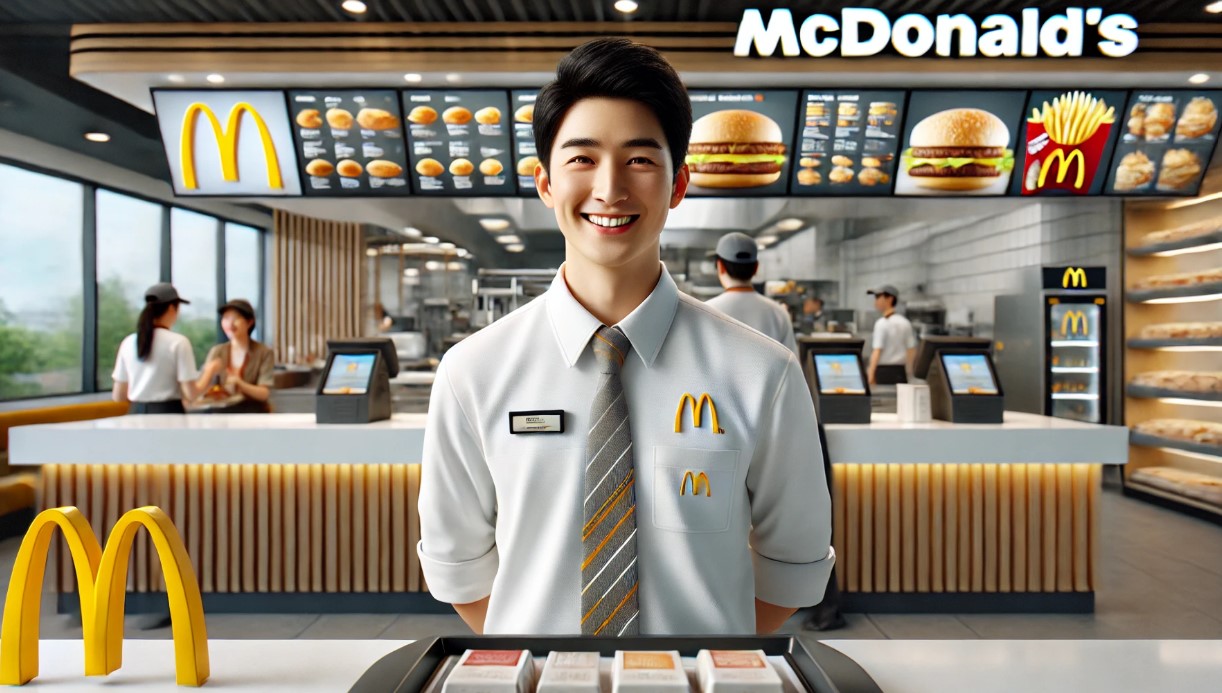As one of the largest and most recognisable fast-food chains in the world, McDonald’s is a cornerstone of the global economy and a significant employer.
In the UK alone, McDonald’s employs tens of thousands of workers, making it a critical part of the employment landscape. Yet, the topic of wages in fast food, particularly at McDonald’s, has long been a subject of debate.
Discussions about minimum wages and living wages often highlight McDonald’s pay structure as a benchmark for the industry.
With public interest in fair pay and employee satisfaction growing, this blog delves into McDonald’s pay rates, compares them with competitors, and examines how they align with national wage laws.
By breaking down the numbers, we aim to provide a clear picture of what McDonald’s employees earn and whether the company’s pay policies reflect the expectations of the modern workforce in the UK.
Understanding McDonald’s Minimum Wage Structure
McDonald’s employs a diverse range of staff, from entry-level workers to experienced managers. The company’s pay structure reflects these varying responsibilities and skill levels, with clear distinctions between roles like Customer Care Assistants and Managers.
Below is an in-depth look at the wages for these two positions, detailing their hourly, monthly, and annual pay scales.

| Job Role | Hourly Pay | Monthly Pay | Annual Pay |
| Customer Care Assistant (lowest paid) | £8–£9 | £1K–£2K | £16K–£19K |
| Manager (highest paid) | £11–£17 | £2K–£3K | £24K–£35K |
Customer Care Assistant: The Entry-Level Role
- Hourly Pay: £8–£9
- Monthly Pay: £1,000–£2,000
- Annual Pay: £16,000–£19,000
The Customer Care Assistant role is the foundation of McDonald’s workforce, often serving as the starting point for new employees. These team members play a vital role in ensuring a seamless customer experience. Their responsibilities typically include:
- Greeting and assisting customers with orders.
- Maintaining cleanliness in the dining and kitchen areas.
- Managing basic operational tasks like restocking and preparing items for customer service.
For many young workers, including students and those seeking part-time work, this role provides a flexible entry into the job market.
While the pay aligns closely with the UK’s minimum wage, the position is often appreciated for its accommodating work schedules and opportunities for advancement within the company.
Despite the relatively modest pay, McDonald’s supplements this role with additional perks such as free meals, discounts, and the potential for overtime pay.
Manager: A Leadership Role with Competitive Pay
- Hourly Pay: £11–£17
- Monthly Pay: £2,000–£3,000
- Annual Pay: £24,000–£35,000
Managers at McDonald’s represent the leadership core of the organisation, taking on significant responsibilities to ensure the smooth running of operations. This role commands a higher pay scale, reflecting the complexity and accountability involved.
Key responsibilities of a McDonald’s Manager include:
- Supervising and managing a team of employees during shifts.
- Overseeing daily operations, including inventory management and scheduling.
- Ensuring customer satisfaction by addressing complaints and maintaining high service standards.
- Meeting sales targets and managing budgets to align with business goals.
- Hiring and training new employees to maintain a skilled workforce.
In addition to the attractive pay, Managers often benefit from long-term career opportunities, including promotions to senior management positions within McDonald’s. The pay range for managers is competitive, often surpassing wages offered by similar roles at rival fast-food chains.
For employees aspiring to grow within the company, this role is often seen as a rewarding step up from entry-level positions, combining leadership experience with financial incentives.
Comparing the Two Roles
The pay disparity between Customer Care Assistants and Managers is driven by the responsibilities and skills required for each role.
While Customer Care Assistants focus on basic operational tasks, Managers handle team leadership, business targets, and customer satisfaction, justifying the significantly higher compensation.
This pay structure is typical of large fast-food chains, where roles are clearly defined, and employees can progress to higher-paying positions with experience and training. McDonald’s also offers internal development programs, helping employees transition from entry-level roles to management positions.
McDonald’s Wage Policies and Industry Comparisons

McDonald’s pay structure is closely tied to the UK’s legal framework for wages, which ensures that workers receive at least the minimum wage based on age and job type. As of 2024, the National Minimum Wage rates are as follows:
| Age Group | Hourly Rate |
| 23 years and over | £10.42 |
| 21–22 years | £10.18 |
| 18–20 years | £7.49 |
| Under 18 | £5.28 |
| Apprentices | £5.28 |
For entry-level roles such as Customer Care Assistant, McDonald’s often starts employees at or slightly above these rates. However, wages for managerial roles are notably higher and competitive with other companies in the fast-food industry.
How Does McDonald’s Compare to Competitors?
- Burger King: Similar hourly pay for entry-level roles, but often with fewer regional wage variations.
- KFC: Comparable wages, but a stronger emphasis on team bonuses rather than individual raises.
- Starbucks: Higher starting wages, particularly in urban areas, but fewer traditional management roles compared to McDonald’s.
McDonald’s positions itself competitively within the fast-food market by offering pay that aligns with national standards while providing opportunities for advancement and additional benefits.
Work Routine of Customer Care Assistants at McDonald’s
The role of a Customer Care Assistant is essential to ensuring a smooth and pleasant experience for McDonald’s customers.
Their daily work routine involves a variety of tasks, primarily focused on customer service, maintaining cleanliness, and assisting in restaurant operations. Here’s an overview of their typical workday:
Preparing for the Shift
- Clocking In: The day begins with clocking in and checking the schedule for assigned tasks or areas.
- Uniform Check: Ensuring they are dressed in the McDonald’s uniform and ready to meet hygiene and safety standards.
- Briefing: Attending a short meeting with supervisors or managers to understand the shift goals, any special promotions, or customer service guidelines for the day.
Greeting and Assisting Customers

- Welcoming Guests: Customer Care Assistants are often the first point of contact. They greet customers warmly, answer questions about the menu, and assist them in placing orders at the counter or self-service kiosks.
- Handling Requests: Assisting with special customer requests, such as dietary needs, extra condiments, or issues with their orders.
- Problem-Solving: Addressing minor complaints or concerns quickly, ensuring customers leave satisfied.
Maintaining Cleanliness
- Dining Area Upkeep: Ensuring tables, chairs, and floors are clean and presentable. This includes wiping down surfaces, clearing trays, and sanitising high-touch areas.
- Waste Management: Emptying bins regularly and sorting recyclable materials according to the company’s environmental policies.
- Restocking Supplies: Refilling napkins, straws, and condiments in the dining area for customer convenience.
Assisting with Food Preparation (as needed)
- Helping in the Kitchen: During busy periods, Customer Care Assistants may assist kitchen staff by preparing drinks, packing orders, or restocking food items.
- Drive-Thru Support: Some assistants may be tasked with aiding drive-thru operations by delivering orders or managing queues.
Customer Feedback and Interactions
- Promoting Loyalty Programs: Informing customers about McDonald’s app, loyalty points, or ongoing promotions to enhance their experience.
- Feedback Collection: Encouraging customers to share feedback, either directly or through surveys, and relaying valuable input to the management team.
Adapting to Shift Demands
- Rush Hour Management: During peak hours, such as lunch or dinner times, Customer Care Assistants focus on queue management, ensuring smooth customer flow and minimising wait times.
- Cross-Functional Tasks: Flexibility is key. Depending on the restaurant’s needs, they might assist in different areas, such as cashier duties, order assembly, or even training new hires.
Closing or Shift End Tasks
- Cleaning and Restocking: At the end of their shift, Customer Care Assistants focus on deep cleaning tasks like mopping floors, sanitising all surfaces, and restocking supplies for the next team.
- Handover Report: Updating the incoming team or manager about any issues or pending tasks to ensure continuity.
- Clocking Out: Completing their timesheet or logging hours digitally before leaving for the day.
Skills Utilised Daily
Customer Care Assistants rely on several soft and hard skills during their routine:
- Communication: Interacting effectively with customers and team members.
- Time Management: Juggling multiple tasks efficiently, especially during busy periods.
- Customer Service: Ensuring every guest feels welcomed and valued.
- Adaptability: Handling a dynamic work environment with changing priorities.
- Teamwork: Collaborating with colleagues to maintain seamless operations.
Why Do Customer Care Assistants Receive the Lowest Pay?

The pay scale for Customer Care Assistants at McDonald’s is among the lowest within the company’s hierarchy, and this is due to several factors that are commonly associated with entry-level positions across many industries. Let’s break down the primary reasons:
Entry-Level Nature of the Role
The Customer Care Assistant position is designed as an entry-level job, making it accessible to individuals with little to no prior work experience.
Many employees in this role are young workers, students, or individuals re-entering the workforce who may not have specialised skills or extensive professional backgrounds.
Since the role does not require formal qualifications or advanced training, the compensation aligns with the minimum pay standards, reflecting its entry-level status.
Basic Responsibilities
The duties of a Customer Care Assistant are fundamental to the operation of a McDonald’s restaurant but do not typically involve high levels of complexity or responsibility. Common tasks include:
- Greeting customers and taking orders.
- Maintaining cleanliness in dining and service areas.
- Restocking supplies and assisting with minor kitchen preparations.
While these tasks are crucial for the day-to-day functioning of the restaurant, they are considered routine and require minimal specialised skills. This distinguishes the role from higher-paid positions that involve strategic decision-making, team leadership, or advanced expertise.
Market Dynamics and Industry Standards
The fast-food industry is known for offering wages that hover around the minimum wage for entry-level positions. McDonald’s competes with similar employers such as Burger King, KFC, and Subway, all of which maintain comparable pay scales for similar roles.
To remain competitive in the market while managing operational costs, McDonald’s aligns its wages for Customer Care Assistants with industry benchmarks. This ensures affordability while still attracting a steady stream of applicants for these positions.
Opportunity for Growth
McDonald’s positions the Customer Care Assistant role as a stepping stone for employees to grow within the company. For many workers, this is their first job, providing essential skills such as customer service, teamwork, and time management.
McDonald’s offers opportunities for promotion to higher-paying roles, such as Shift Leaders and Managers, as employees gain experience and demonstrate their capabilities.
This progression model incentivises employees to stay with the company, where they can move into more lucrative positions over time.
Compliance with Wage Laws
In the UK, McDonald’s adheres to national minimum wage laws, which are based on age and role. Customer Care Assistants, being entry-level employees, are often paid at or slightly above the legal minimum.
For example:
- Workers aged 23 and over receive at least £10.42 per hour (as of 2024).
- Younger workers and apprentices may receive lower rates.
McDonald’s pay for Customer Care Assistants reflects this legal compliance while also offering additional perks, such as free meals and flexible schedules, to enhance job satisfaction.
High Volume of Positions
Customer Care Assistants represent the largest segment of McDonald’s workforce. Since these roles are abundant and require minimal training, the wages are scaled to ensure the sustainability of the business.
Employing thousands of entry-level workers at higher pay rates would significantly increase operational costs, which could impact the company’s pricing and profitability.
Additional Benefits Beyond Wages
For many employees, McDonald’s offers more than just an hourly wage. The company provides various perks aimed at making roles more attractive and supporting worker satisfaction:
- Free or Discounted Meals: Workers enjoy free meals during shifts or discounted menu items, saving on daily expenses.
- Flexible Schedules: Particularly valued by students and part-time workers, McDonald’s offers scheduling options to fit individual needs.
- Training Programs: Apprenticeship schemes, leadership training, and skills development courses are available for employees who wish to grow within the company.
- Employee Discounts: Discounts through McDonald’s partnerships with retailers add extra value for employees.
- Promotion Opportunities: With clear career pathways, many McDonald’s employees advance to higher-paying roles within a few years of joining.
These non-wage benefits play a significant role in retaining workers and making McDonald’s an appealing employer, particularly for younger job seekers.
Conclusion
McDonald’s pay structure offers a nuanced picture of wages within the UK’s fast-food industry. While entry-level wages meet legal requirements, the company stands out for providing competitive managerial pay, clear career pathways, and a range of benefits that enhance the overall employee experience.
However, as discussions about fair pay intensify, McDonald’s faces pressure to bridge the gap between minimum and living wages. For workers and policymakers alike, McDonald’s employment practices remain a vital benchmark for the broader conversation on wages in the UK.
FAQs
What is the average hourly rate for McDonald’s employees in the UK?
The average hourly rate varies by role. Customer Care Assistants earn around £8 per hour, while managers average £13 per hour plus additional pay.
Does McDonald’s pay above the national minimum wage?
Yes, for many roles, McDonald’s offers wages slightly above the minimum wage. However, the pay differs based on job role and location.
What benefits do McDonald’s employees receive?
Employees enjoy free or discounted meals, flexible schedules, training opportunities, and pathways for promotion.
How does McDonald’s support employee career growth?
Through training programs, leadership development, and internal promotions, McDonald’s fosters long-term career growth.
Are McDonald’s wages the same across all UK locations?
No, wages vary depending on regional factors, cost of living, and franchise policies.
How many jobs are currently available at McDonald’s?
There are over 16,700 managerial roles open, in addition to other job positions.
What is the difference between a living wage and a minimum wage?
A minimum wage is legally mandated, while a living wage is a voluntary standard based on the cost of living.




